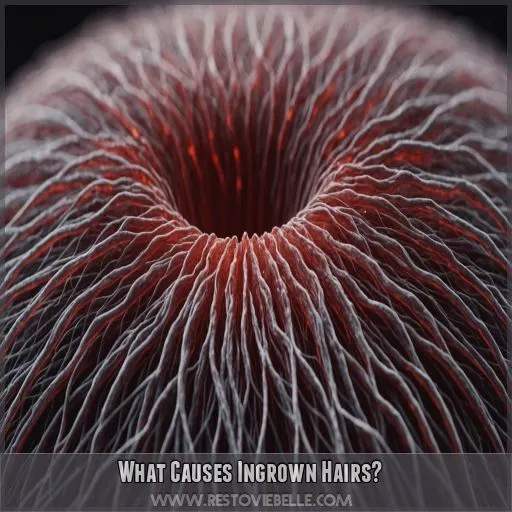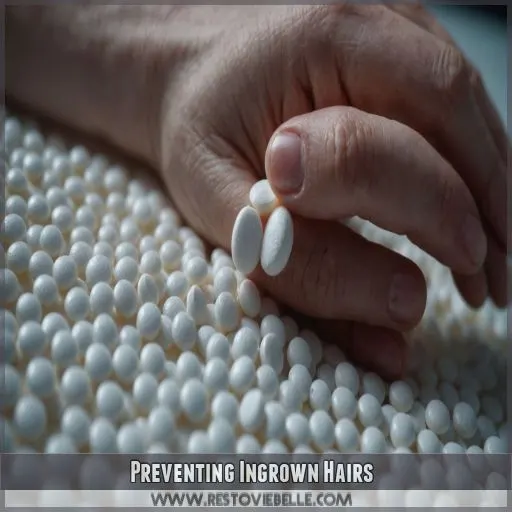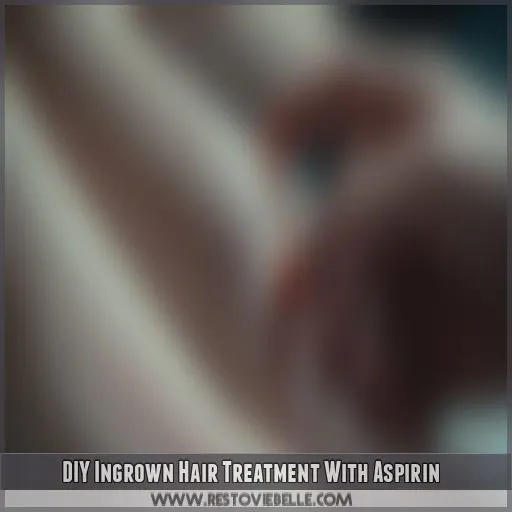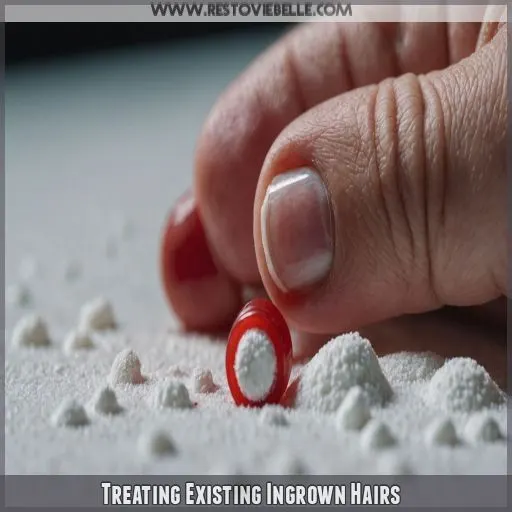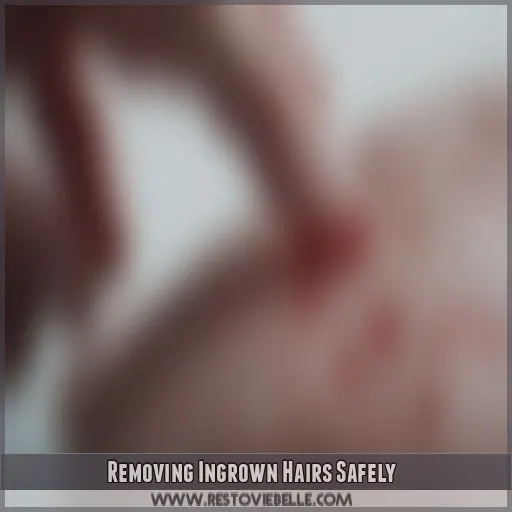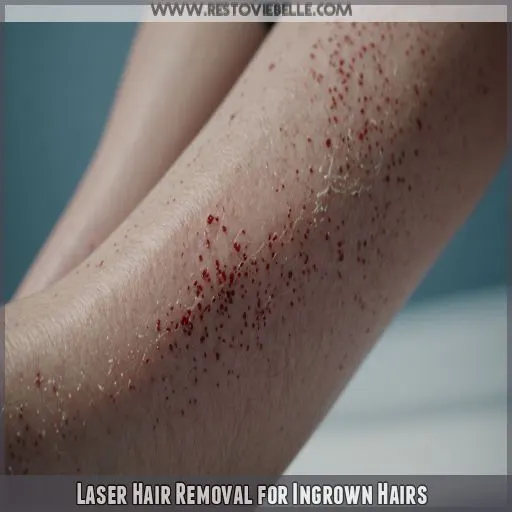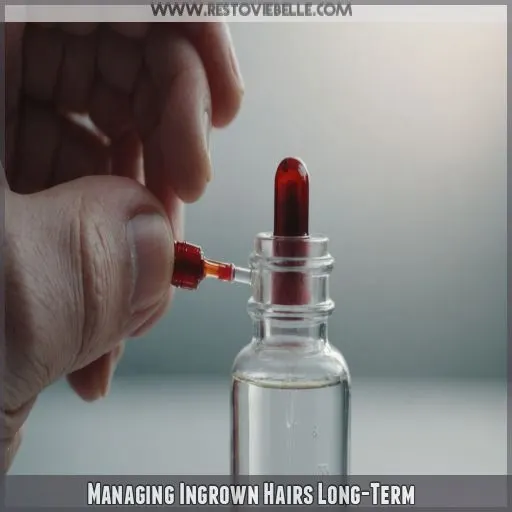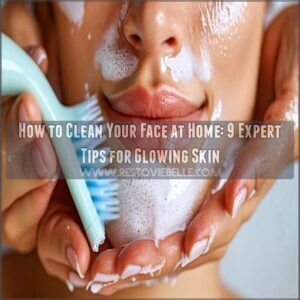This site is supported by our readers. We may earn a commission, at no cost to you, if you purchase through links.
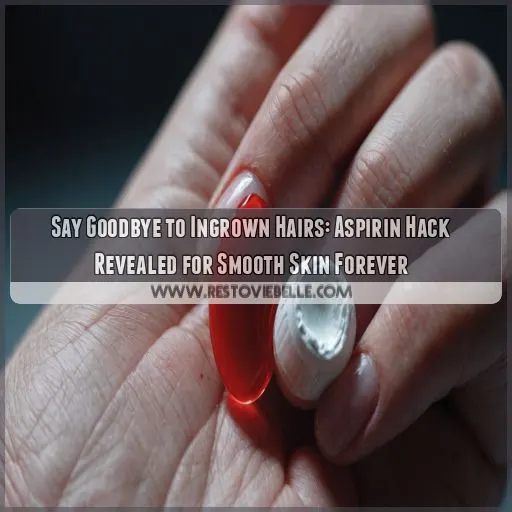 Ingrown Hairs got you down? Don’t worry, you’re not alone! Those pesky red bumps can be painful and frustrating.
Ingrown Hairs got you down? Don’t worry, you’re not alone! Those pesky red bumps can be painful and frustrating.
But, what if I told you there’s an aspirin hack that can help?
Crushing aspirin tablets and mixing them with honey and warm water creates a paste that can gently exfoliate and remove dead skin cells that clog your follicles.
This DIY treatment can help get rid of ingrown hairs and prevent new ones from forming.
Want to learn how to make this magic paste and say goodbye to those unwanted bumps for good? Let’s break it down!
Table Of Contents
- Key Takeaways
- What Causes Ingrown Hairs?
- Preventing Ingrown Hairs
- DIY Ingrown Hair Treatment With Aspirin
- Treating Existing Ingrown Hairs
- Removing Ingrown Hairs Safely
- Laser Hair Removal for Ingrown Hairs
- Managing Ingrown Hairs Long-Term
- Frequently Asked Questions (FAQs)
- What draws out deep ingrown hairs?
- What is the fastest way to get rid of ingrown hair?
- What to put on ingrown hair to draw it out?
- How to make homemade ingrown hair treatment?
- Can I use coated aspirin tablets for the treatment?
- How long does it take to see results from the aspirin treatment?
- Can I use the aspirin treatment on sensitive skin areas?
- Are there any potential interactions with other skincare products?
- Can I use the aspirin treatment during pregnancy or breastfeeding?
- Conclusion
Key Takeaways
- You’ll want to use uncoated aspirin tablets for this treatment, as the coating can interfere with the dissolving process – don’t let those pesky coatings get in the way of your smooth skin goals!
- Before using the aspirin treatment, do a patch test to gauge your skin’s reaction, and consider diluting the solution if you experience any irritation or discomfort – better safe than sorry.
- When using the aspirin treatment, be cautious when combining it with other skincare products, especially those containing salicylic acid or benzoyl peroxide, to avoid potential interactions – you don’t want to create a skincare cocktail that’ll leave you red and irritated.
- You can expect to see noticeable results from the aspirin treatment in 3-5 days, but be consistent and give it a week or two for the best results to kick in – patience is a virtue, especially when it comes to getting rid of those pesky ingrown hairs.
What Causes Ingrown Hairs?
You’re probably all too familiar with the pesky bumps and redness that come with ingrown hairs, but have you ever wondered what causes them in the first place? It turns out that a combination of your hair type, hair removal methods, and even your clothing choices can all contribute to those unwanted ingrown hairs.
Hair Types Prone to Ingrown Hairs
- Curly hair that grows back into the skin
- Coarse hair that’s more likely to cause razor bumps
- Thick hair that’s prone to ingrown hairs due to its texture
- Hair with a unique growth pattern that makes it more likely to get trapped in the skin
How Hair Removal Methods Contribute to Ingrown Hairs
When you shave, wax, or tweeze, you’re basically inviting ingrown hairs to the party. These methods can cause hair to grow back into the skin, leading to redness, bumps, and irritation.
Other Factors That Can Cause Ingrown Hairs
- Hormonal changes: Fluctuations can lead to ingrown hairs, especially in the pubic area.
- Skin friction: Tight clothing can cause friction, leading to ingrown hairs.
- Medication side effects: Some meds can affect your skin barrier, increasing the risk.
How to Identify Ingrown Hairs
To identify ingrown hairs, look for red bumps, razor burn, or painful spots where hair is trapped. Check for inflammation, which can lead to more severe issues.
| Symptoms | Causes | Prevention Tips |
|---|---|---|
| Red bumps | Ingrown hairs, razor burn | Exfoliate, moisturize |
| Razor burn | Shaving, waxing | Use soothing products, avoid tight clothing |
| Hair trapped | Clogged pores, curly hair | Exfoliate, use salicylic acid |
| Inflammation | Ingrown hairs, skin irritation | Apply aloe vera, use cortisone cream |
| Painful spots | Ingrown hairs, infection | Use warm compresses, antiseptic cream |
Preventing Ingrown Hairs
You’re about to become an ingrown hair-fighting pro! To prevent these pesky bumps from ruining your smooth skin, you need to develop a solid skincare routine that includes regular exfoliation, proper moisturizing, and a few simple lifestyle tweaks, like ditching those super-tight clothes that can irritate your skin.
Exfoliating to Prevent Ingrown Hairs
To prevent ingrown hairs, Exfoliate Regularly using gentle tools or homemade scrubs containing salicylic acid, paying extra attention to areas like the bikini line – don’t worry, it’s easy and totally worth it!
How to Exfoliate Correctly
To exfoliate correctly, grab a gentle scrub or exfoliating gloves and massage onto your skin 2-3 times a week. Be gentle, especially on sensitive areas, to avoid irritating your skin and causing more ingrown hairs.
Importance of Moisturizing
To keep your skin ingrown-hair-free, remember to moisturize! Use a hydrating, alcohol-free moisturizer that suits your skin type, and apply it after shaving or waxing to keep your skin hydrated and soothed.
- Look for moisturizers with aloe vera or jojoba oil for their soothing and hydrating benefits
- Use Tend Skin or similar products to help reduce irritation and ingrown hairs
- Apply witch hazel to balance your skin’s pH and reduce inflammation
- Exfoliate regularly to remove dead skin cells and keep your skin healthy
Avoiding Tight Clothing
To prevent ingrown hairs, prioritize comfort over style by choosing loose-fitting clothes and breathable fabrics. Ditch tight clothing, especially for exercise attire, and consider laser hair removal for a more permanent solution.
DIY Ingrown Hair Treatment With Aspirin
You’re about to discover a game-changing hack for smooth skin: a DIY ingrown hair treatment using aspirin that’s easy on the wallet and tough on those pesky bumps. With just a few simple ingredients and some basic mixing skills, you’ll be saying goodbye to ingrown hairs in no time.
Ingredients and Tools Needed
To try the viral aspirin hack, gather 26 uncoated aspirin tablets, witch hazel, rubbing alcohol, two jars, and a crushing tool. This DIY treatment may just become your go-to beauty product for tackling ingrown hairs.
Step-by-Step Instructions for Making the Treatment
Now that you’ve got your ingredients, let’s get mixing! Crush those aspirin tablets in two jars, add rubbing alcohol and witch hazel, and shake until they’re fully dissolved – time to create your DIY ingrown hair treatment!
How to Store and Use the Treatment
Now that you’ve made the aspirin treatment, store it in a clean, sealed jar to prevent evaporation. Shake well before each use and apply morning and night to tackle those pesky ingrown hairs.
Precautions and Potential Side Effects
When using the aspirin treatment, be aware of potential side effects like sun sensitivity, skin irritation, and allergic reactions. To minimize risks:
- Apply sunscreen daily to prevent sun damage
- Moisturize to avoid dryness and discoloration
- Patch test before using the treatment extensively
Treating Existing Ingrown Hairs
You’re probably all too familiar with the pesky bumps and redness that come with ingrown hairs, but don’t worry, there’s hope! In this section, we’ll walk you through some effective ways to treat existing ingrown hairs, from reducing redness to soothing itchy skin, so you can say goodbye to those unwanted bumps for good.
Using Visine to Reduce Redness
You can repurpose Visine eye drops as a quick fix to reduce redness and inflammation caused by ingrown hairs – just mix a drop with your moisturizer and apply it to the affected area.
Applying Black Tea Bag Compresses
You can try applying a warm black tea bag compress to soothe and heal irritated bumps. Steep a tea bag in hot water, let it cool, and apply for 5-7 minutes, 2-3 times a week.
Rubbing Aloe Vera Ice Cubes
Now, try rubbing aloe vera ice cubes on those pesky ingrown hairs. This natural remedy reduces redness, irritation, and pain. Simply freeze aloe vera gel in ice cube trays and gently rub on affected areas.
Using Cortisone Cream for Itching and Inflammation
To soothe itchy, inflamed ingrown hairs, try using cortisone cream. Here are three things to keep in mind:
- Start with OTC: Over-the-counter cortisone creams are available in strengths up to 1%.
- Watch for side effects: Long-term use can lead to skin thinning, so use it sparingly.
- Consult a doc: If the cream doesn’t work or you experience side effects, consider a prescription-strength alternative.
Removing Ingrown Hairs Safely
You’re ready to tackle those pesky ingrown hairs, but before you do, let’s go over how to remove them safely to avoid making things worse. By following some simple steps, you can get rid of ingrown hairs and be on your way to smooth, healthy-looking skin.
Using a Warm Compress to Soften the Area
Now that you’ve reduced the redness, let’s soften the area with a warm compress. Soak a cloth in warm water, wring it out, and apply it for 5-7 minutes, 2-3 times a day.
Gently Removing the Hair With Sterilized Tweezers
Grab those sterilized tweezers and gently coax out the ingrown hair. Be gentle, don’t yank – you want to avoid causing more irritation. Remember, it’s all about finesse, not force.
Applying Antiseptic Cream to Prevent Infection
Now that you’ve gently removed the ingrown hair, apply an antiseptic cream like Neosporin or Bacitracin to prevent infection. Gently massage it in and let it absorb fully before covering the area.
Using Aloe Vera Gel to Soothe and Heal
You’ve successfully removed the ingrown hair – now it’s time to soothe and heal the area! Apply aloe vera gel twice a day to calm the skin and reduce inflammation.
Here are some tips to get the most out of aloe vera gel:
- Choose a pure aloe vera gel: Opt for a brand with minimal additives and no harsh chemicals.
- Apply it correctly: Gently massage the gel into the affected area with a circular motion.
- Combine with other remedies: Mix aloe vera gel with tea tree oil or coconut oil for an extra-soothing treat.
Laser Hair Removal for Ingrown Hairs
You’re probably wondering if there’s a more permanent solution to ingrown hairs beyond DIY treatments and tedious tweezing. Laser hair removal can be a game-changer for you, especially if you have dark, coarse hair that’s prone to ingrown hairs, as it targets and destroys hair follicles to prevent future ingrown hairs.
How Laser Hair Removal Works
When you opt for laser hair removal, specific laser types target and destroy your hair follicles. You’ll typically need multiple sessions, spaced 4-6 weeks apart, to make sure all hairs are zapped.
Benefits of Laser Hair Removal for Ingrown Hairs
Considering laser hair removal? You’ll love the long-term results and reduced ingrown hairs! Although it may require multiple sessions, the cost comparison to other hair removal methods is worth it.
Preparing for Laser Hair Removal
Preparing for laser hair removal? You’re one step closer to saying goodbye to ingrown hairs. Here’s your pre-treatment checklist:
- Get your skin ready: Avoid waxing, tweezing, and tanning for at least 2 weeks prior.
- Schedule a consultation: Discuss your skin concerns, medical history, and expectations with a professional.
- Wear loose, comfy clothing: Ditch tight clothes that may irritate the treated area.
- Plan for aftercare: Set aside time for rest and recovery – your skin will thank you!
What to Expect During and After Treatment
You’re about to undergo laser hair removal, but what’s next? During treatment, you might feel a mild stinging sensation. Afterward, expect some skin irritation, redness, and bumps, but don’t worry, these will subside within a few days.
| What to Expect | Timeline |
|---|---|
| Mild stinging sensation | During treatment |
| Skin irritation, redness, bumps | Immediately after treatment |
| Healing time | 2-5 days |
| Pain relief | Use aloe vera or hydrocortisone cream |
Managing Ingrown Hairs Long-Term
Now that you’ve learned how to treat ingrown hairs with aspirin, it’s time to think about managing them long-term. By incorporating a few simple habits into your daily routine, you can say goodbye to those pesky ingrown hairs for good and enjoy smooth, healthy-looking skin.
Creating a Skincare Routine to Prevent Ingrown Hairs
To create a skincare routine that prevents ingrown hairs, start by understanding your hair growth patterns and shaving techniques. Choose a gentle moisturizer and ingrown hair products that suit your skin type. Develop an exfoliating schedule that keeps your skin smooth and healthy.
Exfoliating Regularly to Prevent Ingrown Hairs
Now that you’ve got a solid skincare routine going, let’s talk exfoliating. To prevent ingrown hairs, you’ll want to exfoliate regularly. Here are some tips:
- Use gentle exfoliating tools like a konjac sponge or a soft washcloth.
- Choose the best scrubs for your skin type, like sugar or salt.
- Exfoliate your body 2-3 times a week, but be gentler on your face.
- Try DIY recipes like a homemade sugar scrub or a chemical exfoliant containing alpha-hydroxy acids (AHAs).
Considering Professional Hair Removal Methods
Now that you’re exfoliating like a pro, consider taking the plunge with professional hair removal methods like laser hair removal, electrolysis, or IPL treatment. Yes, they come with a cost, but think of it as an investment in your sanity and smooth skin forever!
Frequently Asked Questions (FAQs)
What draws out deep ingrown hairs?
Tackling deep ingrown hairs can feel like wrestling an octopus – slippery and stubborn! To draw them out, try applying a warm compress to soften the area, then gently coax the hair to the surface with sterilized tweezers.
What is the fastest way to get rid of ingrown hair?
Want to kick those pesky ingrown hairs to the curb? Try exfoliating regularly, using a warm compress, and applying a DIY aspirin treatment .
What to put on ingrown hair to draw it out?
Want to coax out that pesky ingrown hair? Try applying a warm compress or a paste made from aspirin and water to help bring it to the surface and encourage it to come out on its own.
How to make homemade ingrown hair treatment?
Hey, you can whip up a homemade ingrown hair treatment using crushed aspirin, witch hazel, and rubbing alcohol! Simply mix, shake, and store it in a jar – easy peasy, right?
Can I use coated aspirin tablets for the treatment?
You’ll want to use uncoated aspirin tablets for this treatment, as the coating can interfere with the dissolving process. Coated tablets mightn’t break down properly, making the solution less effective.
How long does it take to see results from the aspirin treatment?
Patience is a virtue" regarding the aspirin treatment. You can expect to see noticeable results in 3-5 days, but be consistent and give it a week or two for the best results to kick in.
Can I use the aspirin treatment on sensitive skin areas?
You’re cautious about using the aspirin treatment on sensitive skin areas, and rightly so! Start with a patch test to gauge your skin’s reaction, and consider diluting the solution if you experience any irritation or discomfort.
Are there any potential interactions with other skincare products?
Did you know 80% of women experience ingrown hairs? When using the aspirin treatment, be cautious when combining it with other skincare products, especially those containing salicylic acid or benzoyl peroxide, to avoid potential interactions.
Can I use the aspirin treatment during pregnancy or breastfeeding?
If you’re pregnant or breastfeeding, it’s best to consult your doctor before using the aspirin treatment. Aspirin can pass into breast milk and may not be suitable for your baby, so let’s play it safe!
Conclusion
The ingrown hair blues got you down! Like a vinyl record stuck on repeat, those pesky bumps just won’t quit.
But now, you’ve got the aspirin hack on your side! By mastering how to get rid of ingrown hairs with aspirin, you’re one step closer to smooth, bump-free skin.

